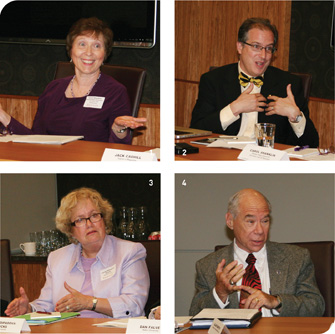
1. Carol Shanklin struck a dominant theme with her opening question about the relationship between graduate programs and business needs. | 2. George Justice said one way to find out what business wants is through greater collaboration. | 3. Soft skills, said Laurie DiPadova-Stocks, are part of the disconnect between business needs and grad-school curriculum. | 4. Allan Rawitch suggested that a regional survey of business needs could help guide programming.
The Higher Education Industry Outlook focus this year was on graduate studies, specifically on the way graduate schools in Missouri and Kansas can interact with the community, especially the business community. Co-chairing the assembly were Dean Carol Shanklin of Kansas State University and Dean George Justice from the University of Missouri, Columbia. Their respective institutions sponsored the Industry Outlook.
Economic Development
To start the questioning, Carol Shanklin questioned her colleagues about the role that graduate programs play in the economic and community development of the state and region.
I always like to say that if you don’t like education,” said Tom Heilke, dean of graduate studies at the University of Kansas, “you should probably go to Sierra Leone and see how it works out for you there.”
Heilke worried that there may be too much emphasis on specific degree programs at the expense of a more ex-pansive view of a university education. He believes that the university should focus on producing “well-educated but broadly educated individuals” and let industry “worry about how they then drill down into details of what’s needed in a particular business.”
Shanklin wondered, on the other hand, whether graduate programs had a more direct responsibility to calibrate its workforce development to the needs of industry in the region.
“How would we know what those needs are?” asked Heilke.
One strategy for finding out, Dean George Justice observed, was to do what MU did: It invited representatives from the Kansas City area life sciences consortium, including experts from industry and government, to do an industry symposium. “We wanted to hear what they needed in terms of post-baccalaureate education,” said Justice. “I would recommend doing something like this. It opened my eyes incredibly.”
“There are some useful work-force projections out there,” said Duane Crawford, associate dean at Kansas State University, “state by state, as well as national.” The projections are highly detailed and call, for instance, for 25,000 health care job openings by 2018 in Kansas alone.
Allan Rawitch, vice chancellor for academic affairs and graduate dean at the University of Kansas School of Medicine, argued for a regional survey to help universities calculate the size of their programs to meet anticipated needs.